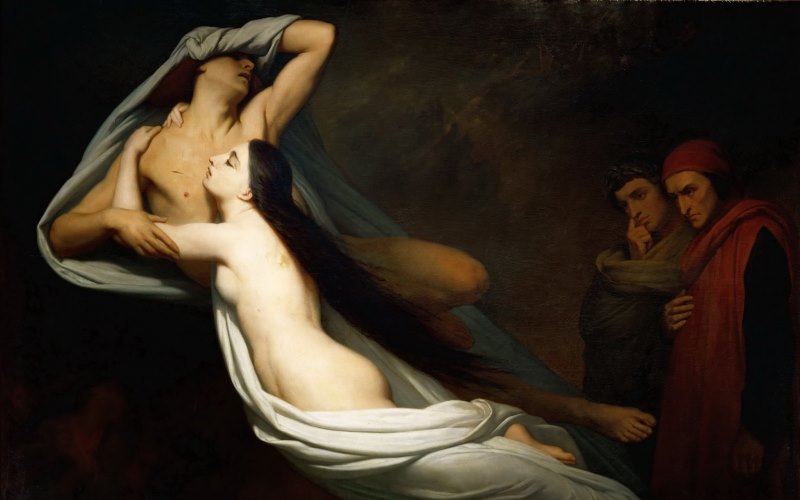
In Rimini on the trail of Paolo and Francesca
Rimini is the setting of one of the most famous love stories in literature; the love story between Paolo and Francesca, described by Dante in the fifth “Canto dell’Inferno”. In the Rimini, it is still possible to trace an itinerary that follows the one that Francesca herself crossed on her journey from her father's house in Ravenna to the Malatesta court in Rimini, where her new life awaited her as the betrothed of Gianciotto Malatesta, Paolo's brother, with whom she would later fall in love.
This itinerary gives visitors the opportunity to discover the same places that, a few decades after the tragic death of the two lovers, Dante had the opportunity to explore and visit while in exile, retracing the tragic story of Francesca through an intense emotional experience.
Valentine's Day is an opportunity to discover Rimini through a romantic journey.
Stop 1 - The Tiberius Bridge Hailing from the ancient via Popilia, Francesca certainly entered the city by crossing the Tiberius Bridge, the two-thousand-year-old bridge over the Marecchia River that, since Roman times, has been marking the entrance to the city for those hailing from the north. Ordered built by Augustus in 14 A.D. and completed by Tiberius in 21 A.D., as confirmed by the inscription on the internal parapets, the monument stands out for its architectural design and construction technique.
Stop 2 - Porta Galliana Porta Galliana is the city gate that connects the city with the harbour area along the Marecchia River, part of the city walls dating back to Frederick's time (thirteenth century). According to Rimini tradition, Porta Galliana is known as the "Arch of Francesca", an explicit reference to the protagonist of Dante's fifth canto. The structure, which for a long time was almost completely underground, was recently restored to its original splendour.
Stop 3 - Arengo Palace At the time of Francesca, the Arengo Palace was one of the venues of power in Rimini, a city where the Malatesta family played an important role from the thirteenth century onwards. The palace was built in 1204 in the central square of the city, today's Piazza Cavour. Thus, it was of recent construction when young Francesca found herself walking in the shade of its façade. While the market took place in the square, the justice court had its seat under the vast portico of the Arango Palace and the Municipal Assembly met in its immense hall on the first floor. Since 2020, the palace, together with the adjacent Podesta residence, has been home to PART - the Museum of Modern and Contemporary Art.
Stop 4 - The Malatesta Palace (Castel Sismondo): we do not know which one of the various palaces owned by the Malatesta family in the city and in the countryside housed Francesca, Gianciotto's wife. Of the houses in Rimini mentioned in the literature, there is only a mention to Castel Sismondo, the residence-fortress that Sigismondo Pandolfo Malatesta built in 1437 and which today houses the Fellini Museum. Even if the inscription on the entrance door bears Malatesta’s claims to have built the fortress ex fundamentis subsequent restoration works revealed that the castle incorporated the previous Roman walls, mediaeval Porta del Gattolo and the core of the Malatesta palaces built in this area since the thirteenth century, a strategic position to control the gate that controlled the escape route to the hinterland castles. A square built near the castle walls was recently dedicated to Francesca and not it hosts a variety of events.
Stage 5 - The Malatesta Temple The "Temple" commissioned by Sigismondo Pandolfo Malatesta in the mid-fifteenth century incorporated and partly destroyed the church dedicated to St. Francis, where members of his family were buried, starting with the "Mastin vecchio da Verucchio", Paolo and Gianciotto’s father, who died at the age of one hundred in 1312 and was mentioned by Dante in the XXVII Canto dell’ Inferno. The Franciscan church was decorated with paintings then lost, with the exception of Giotto's Crucifix, the only work which bears witness to the artist's presence in Rimini at the beginning of the fourteenth century. Sigismondo created magnificence in the Temple, which remained unfinished, bringing together, as in a great ark, the memories of the Family. Artists such as Leon Battista Alberti, Agostino di Duccio and Matteo de' Pasti collaborated on the construction of the Temple, making it a masterpiece of Italian Renaissance.
To complete the itinerary, from 29th December 2021 to Tuesday 25th April 2022, in the City Museum it is possible to visit the exhibition 'The imagined Comedy. Dante's Hell, Purgatory and Paradise illustrated by famous artists', a documentary exhibition on Dante's Hell, Purgatory and Paradise illustrated by famous artists. The exhibition collects some rare examples of ancient Comedies together with the most recent forms of illustrated writing: from graphic novels to manga up to pop-up books, together with the complete the exhibition of the splendid lithographic plates made in 1850 by Franz Adolf Adolf Stürler.

©2016-2023 Assessorato al turismo / Comune di Rimini, Piazzale Fellini 3 47921 - Rimini - +39 0541 704587 / Ufficio Informazioni Turistiche (IAT) +39 0541 53399 / fax +39 0541 56598 / Statistiche web


